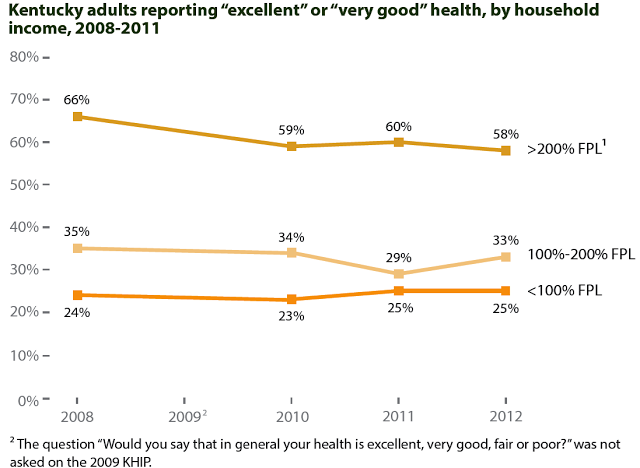Survey suggests Great Recession has harmed the health of Kentuckians

Just over four in 10 Kentucky adults in the latest Kentucky Health Issues Poll described their health as excellent or good. In 2008, almost half used those descriptions.
People with higher incomes have consistently reported better health since the poll began tracking the health status of Kentucky adults 2008. Since research has shown a strong link between higher income and better health, the Great Recession and the resulting increases in unemployment, underemployment and poverty appear to be harming the overall health of Kentucky’s population.
In the accompanying graph, showing responses by income categories, FPL stands for federal poverty level, which in 2011 was a yearly household income of $22,350. Among the categories, 58 percent in the highest category said their health is excellent or good, but only 25 percent of those living in poverty used those descriptions.
Although the health status for each income category has remained fairly constant, the poll reflects federal data that show more people living in poverty. More than 33 percent in the latest poll were earning less than the federal poverty level; in 2008, that was only 19 percent. The polls, which used self-reporting of income and survey methods that differ from federal methods, showed much higher poverty rates than federal data.
“We know there is a direct relationship between income and good health, and these data reflect that,” said Dr. Susan Zepeda, president and CEO of the Foundation for a Healthy Kentucky, a sponsor of the poll. “While changes in our health-care delivery system may provide more health-care opportunities for low-income Kentuckians, these results show how vital a strong economy, and jobs that pay well, are to our population’s health.”
The poll, co-sponsored by the Health Foundation of Greater Cincinnati,
was taken Sept. 20 through Oct. 14 by the Institute for Policy Research at the
University of Cincinnati. A random sample of 1,680 adults throughout
Kentucky was interviewed by landline and cell telephones. The poll’s margin of
error is plus or minus 2.5 percentage points.
